While making plans for our annual spring rockhounding vacation, I discovered information on the NET about monster ammonite fossils that could be collected along the shoreline of Lake Texoma, located on the border of Oklahoma and Texas. I read that the fossil casts reach up to 150 pounds and could be fairly easily collected near the dam. I also read that some sort of boat was a must for transporting tools, equipment and the fossils to and from a boat ramp about 3/4-mile from the main collecting area. While neither Chrissy or I are huge fossil collectors, the opportunity to recover huge ammonites on a Texas lake with a canoe looked like fun, or at least appeared that way on paper . . .
We arrived at Lake Texoma on Thursday, April 5th. It was our plan to check out the collecting area, drive to Sherman, Texas to set up camp at a KOA and then collect ammonites on Friday. We parked near the boat ramp and made our way on foot to where we thought was the collecting area. From our first perspective, we were somewhat concerned that the lake level appeared to be much higher than shown in pictures that we had seen on the NET and, therefore, collecting would not be possible. We walked along the shoreline and were dismayed to discover that the main collecting area was indeed covered with many feet of water. But, we didn't give up hope and continued walking further along the shore while looking for ammonites.
We found plenty of ammonite pieces on the rocky shore, but nothing in situ. Since the lake level was so high and we hadn't worn our rubber boots, we were forced to pick our way through wooded areas adjacent to the lake that were choked with poison ivy. Rather than have Opal get covered with the toxic oil, Chrissy opted to stay behind with her while I carefully kept going.
After walking a total of about a mile, I finally found a section of shoreline where ammonite fossils were sticking out of a shale layer just above the water line. Above the shale was very hard massive limestone. I had purposely not carried any tools with me so as to prevent myself from collecting and getting dirty that day, but temptation got the better of me and the next thing I knew I was standing ankle deep in water and pounding on the limestone strata with a big rock trying to liberate an ammonite. So much for keeping my clothes and new tennis shoes clean and dry. I must have looked like a cave man banging away, but nothing new about that. It took me about 1/2-hour to recover the fossil and I left it there as a marker for the next day.
We got up early Friday morning and drove about 15 miles north to the lake. We found an area near the Dam where Bluebonnets (Texas state flower) and Indian Paintbrush were in full bloom.

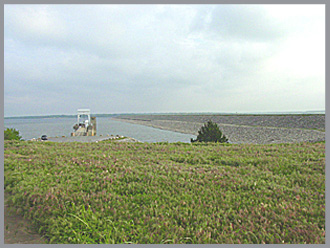 Lake Texoma was built by the Corps of Engineers in the 1940's, and was stocked with black bass and crappie along with the native white bass in the Red and
Washita Rivers. This 89,000 acre lake on the Red River is shared by Texas and Oklahoma. It is widely recognized as a top fishing lake, and is one of the most popular recreation destinations in the Southwest. The lake area includes two wildlife refuges, two state parks, fifty four U.S. Army Corps of
Engineers-managed parks, twenty-six resorts, hundreds of campgrounds and a variety of excellent golf courses. Power boating, power sailing, personal watercraft, water skiers and wind surfers all consider the lake an excellent
Lake Texoma was built by the Corps of Engineers in the 1940's, and was stocked with black bass and crappie along with the native white bass in the Red and
Washita Rivers. This 89,000 acre lake on the Red River is shared by Texas and Oklahoma. It is widely recognized as a top fishing lake, and is one of the most popular recreation destinations in the Southwest. The lake area includes two wildlife refuges, two state parks, fifty four U.S. Army Corps of
Engineers-managed parks, twenty-six resorts, hundreds of campgrounds and a variety of excellent golf courses. Power boating, power sailing, personal watercraft, water skiers and wind surfers all consider the lake an excellent
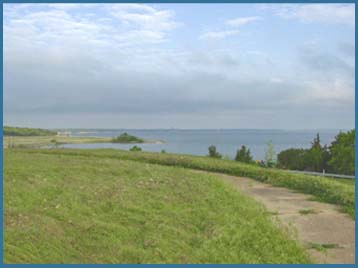 place to have fun. Lake Texoma has become a huge sailing center based on the lake's size, depth and miles of sailing shoreline.
place to have fun. Lake Texoma has become a huge sailing center based on the lake's size, depth and miles of sailing shoreline.
(from http://www.laketexoma.com/)
When we arrived at our parking spot near the boat ramp, it was a bit windy and somewhat cold. According to the weather forecast, the temperature was to rise into the mid fifties and the wind would lessen as the day progressed. We'd later find out the hard way how wrong the forecast was!
We assembled our gear and equipment and placed it in the canoe that we had set near the water next to the boat ramp. The lake was a bit choppy, but not bad enough to make us cancel our plan to paddle the mile or so to the collecting area that I has discovered Thursday. This was Opal's second time in a canoe. I spent about two weeks when she was much younger teaching her to jump into and sit or lay in the canoe while it sat in our front yard. Opal's first actual voyage was on Lake Norris in Tennessee; although nervous at first, she seemed to accept and even enjoy being in the canoe as we paddled across the lake. But, that was on a day when the water was relatively smooth. The choppiness of Lake Texoma made her a bit more nervous, but she bravely got in the canoe and didn't jump out when we got out on the lake. It was a contest between Opal and Chrissy as to who was more apprehensive about heading out that day.
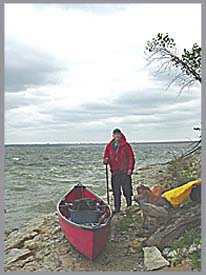 With great effort, we made it to the collecting area where we pulled the canoe onto a limestone shelf well above the water line. I proceeded to the spot that I had marked the day before where ammonite fossils were partially exposed. Chrissy and Opal wandered up and down the shoreline looking for their own specimens.
With great effort, we made it to the collecting area where we pulled the canoe onto a limestone shelf well above the water line. I proceeded to the spot that I had marked the day before where ammonite fossils were partially exposed. Chrissy and Opal wandered up and down the shoreline looking for their own specimens.
I used my trusty 6-pound sawed off sledgehammer, pointed chisel and prybar to bust and pry apart large sections of limestone to expose ammonites in the shaley layer just below. This was very hard work, but I managed to recover a
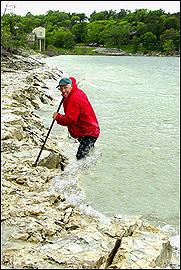 couple fairly large specimens within the first hour or so. Chrissy came over to report that she had found some decent fossils, but would need my help to liberate them. I put this on my list of honey dos, and continued to work my spot.
couple fairly large specimens within the first hour or so. Chrissy came over to report that she had found some decent fossils, but would need my help to liberate them. I put this on my list of honey dos, and continued to work my spot.
Mid-morning, the wind really started to howl and the air temperature seemed to fall. Waves began to crash on the shoreline and into my knee-high boots. The lake water was much warmer than the air so that having filled boots wasn't so bad, but Chrissy was getting chilled having no place to escape the wind and spray.
By late-morning, the wind and waves has increased markedly. I had recovered several decent ammonites, so we decided to get the heck out of there. Since the lake conditions were so bad, we decided that it would be best if Chrissy and Opal walked back to the truck while I paddled the canoe with our equipment, tools and specimens back to the boat ramp. So, we loaded up everything and somehow managed to launch the heavy canoe despite crashing waves and gale force winds.
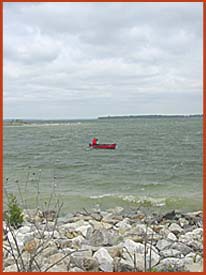 I had to summon every bit of strength and experience that I had to paddle the canoe out against the wind and waves so that I could turn it toward the boat ramp. I had to make my way past three rocky points that jutted out into
the lake. I was half way to the 2nd rocky point when the wind got even stronger. I fought with all my strength to turn the boat into the wind so that I would be able to clear the rocks, but after about 20 minutes, I was forced to admit to myself that I would never win this fight. I realized that the canoe was loaded too heavy in the back with just me in it so that the front was too high and, therefore, took the wind like a sail. There was no way that I would ever be able to turn the canoe, so I let the waves carry me to shore. Luckily, I landed in a cove that was covered in loose rocks instead of a shear cliff as were other portions of the shoreline. Chrissy and Opal met me there. I
really didn't want to head back out into that rough water, but this was preferable to hauling the canoe and all our stuff 3/4-mile to the truck. So,
I had to summon every bit of strength and experience that I had to paddle the canoe out against the wind and waves so that I could turn it toward the boat ramp. I had to make my way past three rocky points that jutted out into
the lake. I was half way to the 2nd rocky point when the wind got even stronger. I fought with all my strength to turn the boat into the wind so that I would be able to clear the rocks, but after about 20 minutes, I was forced to admit to myself that I would never win this fight. I realized that the canoe was loaded too heavy in the back with just me in it so that the front was too high and, therefore, took the wind like a sail. There was no way that I would ever be able to turn the canoe, so I let the waves carry me to shore. Luckily, I landed in a cove that was covered in loose rocks instead of a shear cliff as were other portions of the shoreline. Chrissy and Opal met me there. I
really didn't want to head back out into that rough water, but this was preferable to hauling the canoe and all our stuff 3/4-mile to the truck. So,
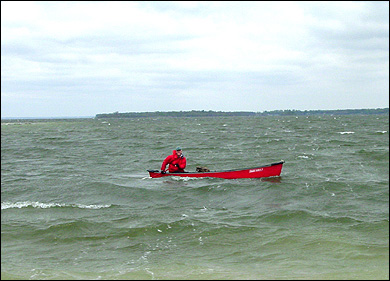 we re-arranged the gear so that the canoe was not back heavy, and I re-launched.
we re-arranged the gear so that the canoe was not back heavy, and I re-launched.
With the weight right, I was just able to paddle back out so that I could clear both rocky points. I was never in any real danger myself since I never got more than 100 yards from shore and I'm a former lifeguard who is at home in the water, but all our tools, equipment and specimens would have surely been lost had I turned over. As if paddling at a near right angle to the 35-mph wind and 2-4 ft wave direction wasn't difficult enough, my slippery rain pants made me have to continually struggle to not slide off the wet seat. I wasn't allowed to stop paddling for even a second during the 45 minutes that it took me to get back or else I would have ended up on the rocks. There was a whole lot of swearing to be heard on the lake that day, had anybody else been insane enough to be out there. But, I finally made it back to the boat ramp.
The wind and cold made stowing all our gear even worse than being on the lake. By the time that we were finished and pulled out, Chrissy and I were shivering and probably suffering from mild cases of hypothermia. When Chrissy asked me if I thought that it was worth it, I answered "$%&@ NO!" but told her to ask me again after I put a few days of being on warm solid ground under my feet.
The following picture shows all of what we recovered that day.
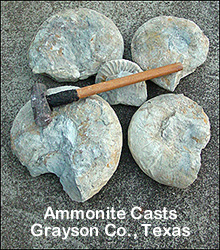
(sledge is about 20-inches long)
It is hard to believe that we did all that for a small pile of stinking fossils (just kidding my fossil hounding friends).